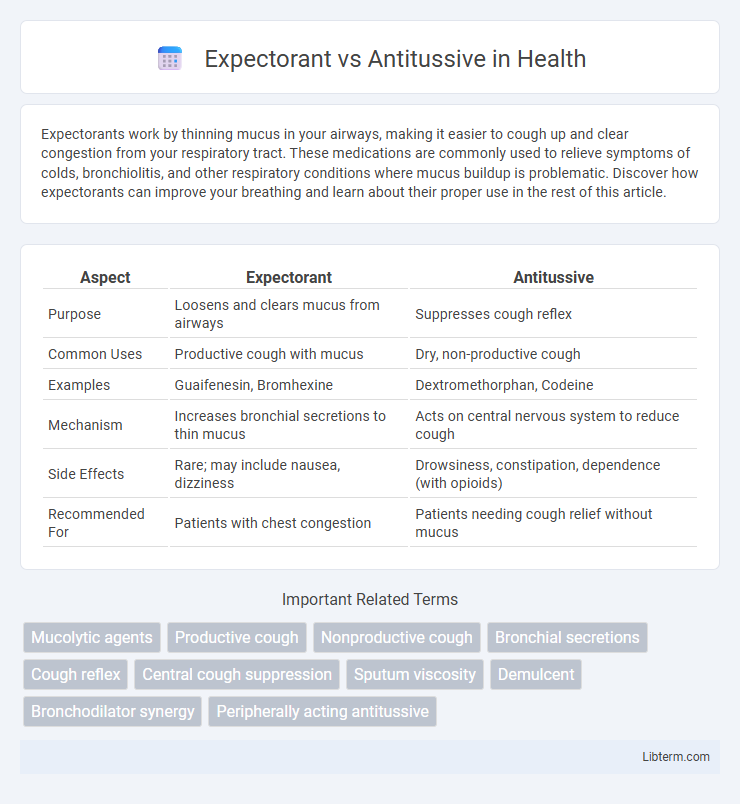Expectorants work by thinning mucus in your airways, making it easier to cough up and clear congestion from your respiratory tract. These medications are commonly used to relieve symptoms of colds, bronchiolitis, and other respiratory conditions where mucus buildup is problematic. Discover how expectorants can improve your breathing and learn about their proper use in the rest of this article.
Table of Comparison
| Aspect | Expectorant | Antitussive |
|---|---|---|
| Purpose | Loosens and clears mucus from airways | Suppresses cough reflex |
| Common Uses | Productive cough with mucus | Dry, non-productive cough |
| Examples | Guaifenesin, Bromhexine | Dextromethorphan, Codeine |
| Mechanism | Increases bronchial secretions to thin mucus | Acts on central nervous system to reduce cough |
| Side Effects | Rare; may include nausea, dizziness | Drowsiness, constipation, dependence (with opioids) |
| Recommended For | Patients with chest congestion | Patients needing cough relief without mucus |
Introduction to Expectorants and Antitussives
Expectorants are medications that help loosen mucus in the airways, making it easier to cough up and clear from the respiratory tract. Antitussives suppress the cough reflex by acting on the brain's cough center, reducing the frequency and intensity of coughing. Both expectorants and antitussives are commonly used to manage symptoms of respiratory conditions such as bronchitis, common cold, and flu.
What Are Expectorants?
Expectorants are medications designed to thin and loosen mucus in the airways, facilitating easier coughing and clearing of the respiratory passages. Common expectorants like guaifenesin increase the hydration of respiratory tract secretions, promoting a productive cough to expel phlegm. These agents are primarily used in treating conditions such as bronchitis, common cold, and other respiratory infections where mucus buildup impairs breathing.
How Expectorants Work
Expectorants work by thinning mucus in the airways, making it easier to cough up and clear congestion. These medications stimulate the secretion of respiratory tract fluids, which loosens and thins sputum, promoting effective expectoration. Common expectorants like guaifenesin help improve airflow and reduce chest discomfort associated with thick mucus buildup.
Common Types of Expectorant Medications
Common types of expectorant medications include guaifenesin, which helps thin and loosen mucus in the airways to facilitate coughing and clear congestion. Potassium iodide and ammonium chloride are less commonly used expectorants that stimulate respiratory tract secretions, aiding mucus expulsion. These medications are typically used in conditions like bronchitis, asthma, and COPD to improve airway clearance.
What Are Antitussives?
Antitussives are medications specifically designed to suppress or reduce the cough reflex by acting on the central nervous system or local throat receptors. They are commonly used to alleviate dry, non-productive coughs that cause discomfort without aiding mucus clearance. Examples of antitussive agents include dextromethorphan, codeine, and benzonatate, which help improve patient comfort by decreasing coughing frequency and intensity.
How Antitussives Work
Antitussives suppress the cough reflex by acting directly on the brain's cough center in the medulla oblongata, reducing the urge to cough. These medications can be classified into central antitussives, such as dextromethorphan and codeine, which inhibit neural pathways responsible for triggering cough. Unlike expectorants that facilitate mucus clearance, antitussives primarily aim to decrease the frequency and intensity of coughing episodes.
Common Types of Antitussive Medications
Common types of antitussive medications include dextromethorphan, codeine, and benzonatate, which work by suppressing the cough reflex in the brain. Dextromethorphan is widely used over-the-counter and effective for dry, non-productive coughs. Codeine, a narcotic, requires prescription and provides stronger cough suppression but with potential side effects and dependence risk.
Key Differences Between Expectorants and Antitussives
Expectorants and antitussives serve distinct purposes in cough management, with expectorants primarily thinning mucus to facilitate productive coughing and clear airways, while antitussives suppress the cough reflex to reduce coughing frequency and intensity. Expectorants, such as guaifenesin, are ideal for wet coughs associated with mucus buildup, whereas antitussives like dextromethorphan are used for dry, non-productive coughs that cause irritation. Understanding these key differences ensures effective treatment tailored to the type and cause of cough symptoms.
When to Use Expectorants vs Antitussives
Expectorants are used to loosen and thin mucus in the airways, making it easier to cough up and clear chest congestion, especially in productive coughs. Antitussives are recommended for dry, non-productive coughs where suppressing the cough reflex helps reduce irritation and improve rest. Knowing when to choose an expectorant or antitussive depends on the cough type: use expectorants for mucus buildup and antitussives for persistent cough without mucus.
Safety Considerations and Side Effects
Expectorants like guaifenesin are generally safe when used as directed, promoting mucus clearance with minimal side effects such as mild gastrointestinal discomfort. Antitussives, including dextromethorphan and codeine, carry higher risks like drowsiness, dizziness, and potential respiratory depression, especially in overdose or combination with other sedatives. Both classes require caution in patients with chronic respiratory conditions, pregnancy, or polypharmacy to avoid adverse interactions and complications.
Expectorant Infographic

 libterm.com
libterm.com